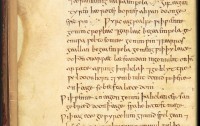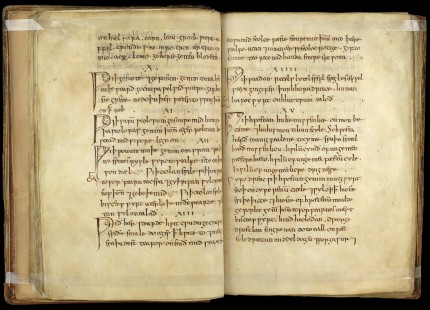One of my all-time favorite stories has an update. In 2015, microbiologists at  the University of Nottingham collaborated with an Anglo-Saxon expert from the university’s English department to recreate a 10th century recipe for a salve purported to treat eye infections. The combination of onion, garlic, wine and bovine bile steeped together in a bronze or brass vessel was then tested on flourishing cultures of Methicillin-resistant Staphylococcus aureus (MRSA) and found to be a MRSA-killing machine. The individual ingredients did nothing; the control batch minus the vegetable ingredients did nothing. The full salve obliterated 999 Staphylococcus cells in 1,000, both for in vitro cultures and in vivo on infected mice. Even a diluted version of the salve was a powerful weapon. It couldn’t kill MRSA, but it blocked the bacterial cell-cell communication it needs to damage tissue.
the University of Nottingham collaborated with an Anglo-Saxon expert from the university’s English department to recreate a 10th century recipe for a salve purported to treat eye infections. The combination of onion, garlic, wine and bovine bile steeped together in a bronze or brass vessel was then tested on flourishing cultures of Methicillin-resistant Staphylococcus aureus (MRSA) and found to be a MRSA-killing machine. The individual ingredients did nothing; the control batch minus the vegetable ingredients did nothing. The full salve obliterated 999 Staphylococcus cells in 1,000, both for in vitro cultures and in vivo on infected mice. Even a diluted version of the salve was a powerful weapon. It couldn’t kill MRSA, but it blocked the bacterial cell-cell communication it needs to damage tissue.
The results were exciting but the research was in its infancy five years ago. Now the team has published a new paper on the use of Bald’s eyesalve on a range of pathogens in biofilms, communities of bacteria that form a protective shield that is to all intents and purposes impossible to destroy no matter how many antimicrobials you launch at it. Most pharmacological studies of plant ingredients focus on isolating active compounds and using them against planktonic (free-living) bacteria cells which are easier to kill than biofilms. This study explored the antimicrobial properties of the mixture.
Biofilm infections of wounds (e.g. burns, diabetic foot ulcers), medical implants (e.g. artificial joints, catheters), the lungs (e.g. in cystic fibrosis) and other body sites impose a major health and economic burden and can be effectively untreatable. Non-healing, infected foot ulcers, which can be a complication of diabetes, provide an especially sobering example. Even if the infection is apparently successfully treated, there is a high chance of recurrence and an estimated 50% of those affected die within 5 years of ulcer development. Management of diabetic foot ulcers costs the UK’s NHS £650 M per year. […]
Each of Bald’s eyesalve ingredients has known antimicrobial properties or compounds (onion and garlic, bile, wine). We explored the contribution of all four ingredients to both planktonic and biofilm activity of Bald’s eyesalve to build a picture of their relative contributions. Planktonic activity appeared almost entirely attributable to garlic. However, tests against S. aureus Newman biofilms, grown in a synthetic wound model, showed garlic exhibited no antibacterial activity in this more clinically-relevant setting. In fact, no preparation which omitted any one ingredient possessed full activity in the biofilm assay. This confirms our previously published finding that Bald’s eyesalve anti-biofilm activity is contingent on the presence of all four ingredients.
The Voltron force of Bald’s eyesalve was able to completely eradicate planktonic cultures of a number of bacteria including P. aeruginosa, A. baumannii, E. cloacae, S. maltophilia, S. aureus, S. epidermidis, S. pyogenes and MRSA. It was also able to slaughter cells in biofilms S. aureus Newman, A. baumannii and S. pyogenes. Interestingly, while the salve was effective against planktonic cultures of P. aeruginosa, E. cloacae and S. maltophilia, it was ineffective against their biofilms. This discovery underscores how important it is to include biofilms in any studies of antibacterial compounds because being able to kill planktonic cultures bears no relation to being able to break down biofilm.
Because people asked in the comments five years ago (and are still asking today), here’s the recipe for Bald’s eyesalve used by the research team.
Garlic and onions were purchased from supermarkets or greengrocers. As lab work continued throughout all seasons of the year, and was conducted in two locations (Warwick and Nottingham), it is possible that different varieties of garlic and onion, or the same variety grown in different locations, were used in different batches of the eyesalve. The outer skin of the garlic and onion (sourced from local greengrocers) was removed. The garlic and onion were finely chopped, and equal volumes of garlic and onion were crushed together using a mortar and pestle for 2 min. Various sized batches of Bald’s eyesalve were used throughout this paper, ranging from final volumes of 30 ml–400 ml, the average weight used was 14.1 ± 1.5 g of onion and 15.0 ± 1.3 g of garlic per 100 ml of Bald’s eyesalve.
The crushed onion and garlic were then combined with equal volumes of wine (Pennard’s organic dry white, 11% ABV, sourced from Avalon Vineyard, Shepton Mallet) and bovine bile salts (Sigma Aldrich) made up to 89 mg·ml−1 in water and sterilised by exposing to UV radiation for 10 min (Carlton Germicidal Cabinet fitted with a 2537 Å, 8-W UV tube). The mixture was stored in sterilised glass bottles in the dark at 4 °C for 9 days, after which it was strained and centrifuged for 5 min at 1,811 g. The supernatant was then filtered using Whatman 1,001–110 Grade 1 Qualitative Filter Paper, Diameter: 11 cm, Pore Size: 11 μm. Filtered Bald’s eyesalve was stored in sterilised glass vials in the dark at 4 °C.
A little more specific than Oswald Cockayne’s original instructions in the incomparable Leechdoms, Wortcunning, and Starcraft of Early England and not exactly easily reproduced in the home. Still, at least the proportions are there for any adventurous souls.

Why would the scientists just drop the bronze or brass vessel?
…efeleác, cnopleác, vyne wiþ whatever might be ‘bovine bile’ in Saxon?!? The particular type of onion or garlic used seems to play a role (genim cropleác = take garlic), but should it not read ‘cnopleác’ instead (cf. ‘Knoblauch’ in German)? Moreover, is there a complete transcribed Anglo-Saxon text of “Bald’s Leechbook” available? Is there really no remedy against Bald’s handwriting?
The ‘Deutsches Wörterbuch’ (DWB) was begun by the Brothers Grimm in 1838 and the initial volumes were published in 1854. In 1999 a new paperback printing of all 33 volumes (a weight of 30+ kg) became available. Luckily, the digitized edition of the DWB is internet-surfable. The DWB mentions ‘English Garlic‘ (Allium babingtonii / Allium ampeloprasum) from Western England and Ireland:
“Den Englischen Knoblauch […] der Zwiebeln statt des Samens trägt” (bearing onion instead of the garlic seed). Notably, ‘Allium ampeloprasum’ has been differentiated into five cultivated vegetables, namely leek, elephant garlic, pearl onion, kurrat, and Persian leek. Unfortunately, I am still not convinced that pearl onion heals anything at all, but maybe I should read the paper 😉
Here you go,…
OK, ‘w(a)enne‘ can only be a Saxon hint to ‘Methicillin-resistant Staphylococcus aureus‘ :confused:
————
XVI. Wiþ þon ðe eagan tyren: rudan seaw & gate geallan & doran hunig ealra emfela. Gif eagan tyren, heorotes hornes ahsan do on geswet win . Wyrc eagsealfe wiþ wænne, genim cropleac & garleac begea emfela, gecnuwa wel tosomne, genim win & fearres geallan begea emfela, gemeng wiþ þy leace, do þonne on arfæt, læt standan nigon niht on þam arfate, awring þurh claþ & gehlyttre wel, do on horn & ymb niht do mid feþere on þæt eage, se betsta læcedom.
16. Wise against eye tearing: rue juice and goat gall and humble bee honey, all equal. Given that the eyes tear, hart’s horn ash pour in sweetened wine. Make eyesalve against ‘wænne’, take leek and garlic, of both equal, knead well together, take wine and taurus gall, of both equal, mix with your leek, put then in ‘arfæt’ [i.e. the bronzen vessel], let stay nine nights therein, wring through cloth and lauter well, put in a horn, and for the night put with a feather onto the eye, the best remedy.
————
Thank you
@Jim – The pot may also play a role, and indeed I would repeat the test with a copper vessel instead of those ‘sterilised glass bottles’ and see if there is any difference:
The term ‘arfæt‘ would be ‘made from copper’ (ǽr), while ‘wenne‘ would be similar to a τύλος. Copper, however, has likewise antibiotic features. Apparently, the “eyesalve” is also a remedy against leishmaniasis (of course at least not necessarily the “best one”). As mentioned, the type of garlic and onion is important.
A completely different story might be, where ‘Bald’ got his knowledge from:
In addition to some kind of tradition among themselves, written ancient sources from the Mediterranean would come to mind, maybe surviving ‘druidic’ expertise, of which Caesar claims that they needed twenty years of learning, but did not take any written notes at all (despite the fact that –according to Caesar– Greek writing was known and used, but only for everyday purpose).
See also: ὀρείχαλκος (from oros=mountain and chalkos=copper), literally “mountain copper”.
Maybe one last remark (I promise):
According to “welterbe-klostermedizin”, which I just googled up, a glass vessel had been used in the experiment(s), but indeed metal and/or copper stripes had been added.
The “Leechbook” comes in three parts. As sources for the first two parts, Galen (Γαληνός), Philagrius of Epirus (Φιλάγριος ὁ Ηπειρώτης), Antyllus (Ἄντυλλος) und Soranus of Ephesus (Σωρανός ὁ Ἑφέσιος) were allegedly identified.
:hattip:
Thank you.
I questioned it, knowing that silver is so-active.
When something like this works so well I wonder how in the world anyone figured out this combination of ingredients would work so well. Then I want to know did these scientists or any other try any of the other recipes in the book.
Where in the world would one get bovine bile? Not at the local grocers. I suppose a farmer could oblige. But what made the first person trying to make the salve say, “you know, garlic, onions and wine are great, but what we really need is some cow bile.” And I just googled it, and it turns out you can buy bovine bile in capsule form. Who knew? Not I.
Excellent question.
Based on my research comparing bronze and brass, bronze has known wound healing properties.
Excellent question!
Based on my research comparing bronze and brass, bronze has known wound healing properties.
If I were to try to replicate Balds recipe, I would use a bronze container.
Detailed 2020 article from Nature
https://www.nature.com/articles/s41598-020-69273-8.pdf